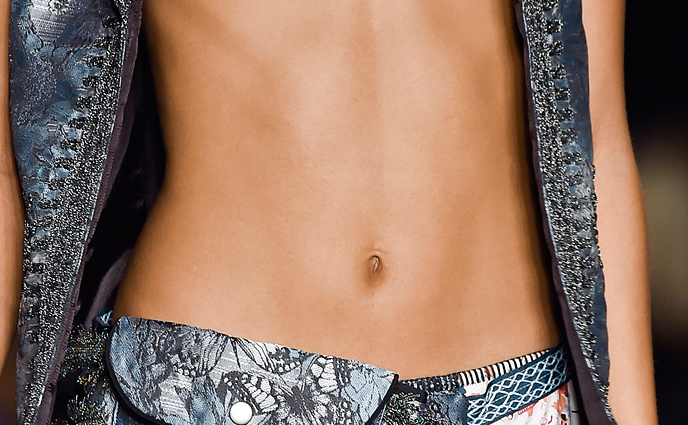What do you get when you pass a human baby through a vaginal opening? A baby (duh) and a whole lot of wear and tear on your lady bits. But how exactly does labor transform your pubic area? According to Stevens, the labia minora tend to get torn and elongate, while the labia majora lose volume and get saggy. The inner part of the vagina can become loose and dry; the clitoral hood becomes elongated and the pelvic floor weakens, leading to urinary incontinence (peeing yourself when you cough, sneeze or laugh). Though after that laundry list of womb gloom-and-doom, we're not convinced many new moms are doing a whole lot of LOL-ing.
Mommy Makeover: If your kegel muscles are clenched in horror, fear not: There are non-surgical solutions to revamp your vulva and vadge. To tighten loose vaginal walls, doctors insert a wand-like device called ThermiVa into the vaginal opening, which uses radiofrequency energy to heat and tighten the area. It also increases mucosal moisture (meaning you can put down that K-Y) and helps treat incontinence (so you click on those funny viral videos in your Facebook feed without worrying you'll wet your pants). Likewise, the ThermiVa can tighten loose or hanging inner and outer vaginal lips using the same radiofrequency energy. "It's absolutely amazing," says Schwartz. "The tightening effects you get everywhere are great."
For loose, deflated-looking labia, Jegasothy says an injection of Restylane or Juvederm can help fill out your downtown pout. That's right, we're talking fillers for fuller lips. Because they're temporary, plan on getting new injections every two to three years.
Cost: $5,000 for three ThermiVa treatments (with one to three treatments depending on degree of vaginal looseness) $700 - $1,500 for vaginal fillers
Mommy Makeover: If your kegel muscles are clenched in horror, fear not: There are non-surgical solutions to revamp your vulva and vadge. To tighten loose vaginal walls, doctors insert a wand-like device called ThermiVa into the vaginal opening, which uses radiofrequency energy to heat and tighten the area. It also increases mucosal moisture (meaning you can put down that K-Y) and helps treat incontinence (so you click on those funny viral videos in your Facebook feed without worrying you'll wet your pants). Likewise, the ThermiVa can tighten loose or hanging inner and outer vaginal lips using the same radiofrequency energy. "It's absolutely amazing," says Schwartz. "The tightening effects you get everywhere are great."
For loose, deflated-looking labia, Jegasothy says an injection of Restylane or Juvederm can help fill out your downtown pout. That's right, we're talking fillers for fuller lips. Because they're temporary, plan on getting new injections every two to three years.
Cost: $5,000 for three ThermiVa treatments (with one to three treatments depending on degree of vaginal looseness) $700 - $1,500 for vaginal fillers
Mama Drama: The stress of having a newborn may make you feel like pulling your hair out but you shouldn't -- because your body has that whole rapid hair loss thing covered post-delivery. When you're pregnant, explains Dr. Tabasum Mir, MD, a dermatologist who specializes in non-invasive cosmetic treatments, the extra estrogen in your body is really great for your hair; it grows faster, it feels thicker and it's not falling out. But once your estrogen levels return to normal and your mane doesn't have that hormonal boost, it starts to fall out at a rate that alarms many a mama. "The actual hair phenomenon is called telogen effluvium," explains Jegasothy. "The different hairs on your head are at different cycles at any given time, but if you have a major trauma or incident -- such as a surgery, an illness or pregnancy -- it can cause all of the hair to go into the dropping or catagen phase of growth." So, basically, just as your baby's hair starts coming in, yours starts disappearing.
Mommy Makeover: Some doctors will tell you that you only think you're losing hair because you got accustomed to your estrogen-enhanced, voluminous strands, but that's little comfort when you're finding clumps of hair in the shower drain. If you don't want to wait out the temporary hair loss (normal hair growth tends to resume about a year after giving birth), platelet-rich plasma scalp injections can offer a fix. A doc takes growth factors found in a person's blood and injects 'em into the scalp, leading to what Jegasothy says is a typical 30 percent increase in growth.
Cost: $500 - $1,000 depending on level of hair loss
Mommy Makeover: Some doctors will tell you that you only think you're losing hair because you got accustomed to your estrogen-enhanced, voluminous strands, but that's little comfort when you're finding clumps of hair in the shower drain. If you don't want to wait out the temporary hair loss (normal hair growth tends to resume about a year after giving birth), platelet-rich plasma scalp injections can offer a fix. A doc takes growth factors found in a person's blood and injects 'em into the scalp, leading to what Jegasothy says is a typical 30 percent increase in growth.
Cost: $500 - $1,000 depending on level of hair loss
Mama Drama: With all those middle-of-the-night feedings, you may feel so exhausted that you think you're seeing spots -- and you are. They just happen to be on your face. Known as pregnancy mask, these spots have nothing to do with sleep deprivation and everything to do with the crazy hormone surge (particularly of estrogen) that you experienced during pregnancy, which can lead to melasma or the development of brown, blotchy spots across your cheeks, forehead, nose and even your upper lip area. Cool, because nothing says motherhood like a 'stache-like shadow.
Mommy Makeover: If you're interested in treating baby to the IRL version of "see Spot go," Mir recommends a series of chemical peels. "Not only are you lightening the dark spots, but you're improving the overall texture of your skin," she says of the procedure. "Chemical peels can also help with wrinkles, enlarged pores, creepiness and blotchiness." Plan on four to six sessions to kiss those brown spots goodbye.
Cost: $90 per chemical peel
Mommy Makeover: If you're interested in treating baby to the IRL version of "see Spot go," Mir recommends a series of chemical peels. "Not only are you lightening the dark spots, but you're improving the overall texture of your skin," she says of the procedure. "Chemical peels can also help with wrinkles, enlarged pores, creepiness and blotchiness." Plan on four to six sessions to kiss those brown spots goodbye.
Cost: $90 per chemical peel
Mama Drama: OK, so you may have prepared yourself for drastic changes to your boobs and belly, but you thought you'd surely have (unblemished) legs to stand on post-baby, right? Well, not quite. Turns out that burgeoning bundle of joy in your womb can affect your limbs, too. "The baby physically rests on the veins in the pelvis, and that causes excess pressure on the leg veins, causing spider veins to pop out," says Jegasothy. Yep, that sounds in the same, ahem, vein as the other body-altering results that pregnancy produces.
Mommy Makeover: Your attempts to eradicate your spider veins don't have to be in vain -- that is, if you have a little help from your medical professional. To treat spider veins, Jegasothy recommends two laser treatments depending on whether or not you're done having kids.
For mommies still growing their brood, the Vbeam pulsed dye laser can offer a quick fix until you're ready for baby No. 2 (who may cause you to develop new spider veins). "Vbeam can erase leg veins with one session," says Jegasothy. "It works by sending an intense pulse of light into the skin. The blood vessel below the skin absorbs the light, which destroys the blood vessels and allows them to be reabsorbed into the body." In the past, leg veins would recur after six to 12 months, but with Vbeam, we can bring down leg vein treatment to every two to three years."
If, on the other hand, you're done having babies and want to permanently banish your veins, Jegasothy recommends endovenous foam ablation, which she refers to as the "gold standard for leg vein treatment." For this outpatient procedure, a vascular surgeon "injects a detergent foam into the main vein at the top of the thigh and eliminates all of your unnecessary leg veins at once, while preserving the deep, necessary veins you need for your legs to function." Don't worry -- patients are under mild sedation when undergoing this treatment.
Cost: $475 per Vbeam treatment with the possibility of needing an additional treatment every two to three years
$2,000 for endovenous foam ablation
Mommy Makeover: Your attempts to eradicate your spider veins don't have to be in vain -- that is, if you have a little help from your medical professional. To treat spider veins, Jegasothy recommends two laser treatments depending on whether or not you're done having kids.
For mommies still growing their brood, the Vbeam pulsed dye laser can offer a quick fix until you're ready for baby No. 2 (who may cause you to develop new spider veins). "Vbeam can erase leg veins with one session," says Jegasothy. "It works by sending an intense pulse of light into the skin. The blood vessel below the skin absorbs the light, which destroys the blood vessels and allows them to be reabsorbed into the body." In the past, leg veins would recur after six to 12 months, but with Vbeam, we can bring down leg vein treatment to every two to three years."
If, on the other hand, you're done having babies and want to permanently banish your veins, Jegasothy recommends endovenous foam ablation, which she refers to as the "gold standard for leg vein treatment." For this outpatient procedure, a vascular surgeon "injects a detergent foam into the main vein at the top of the thigh and eliminates all of your unnecessary leg veins at once, while preserving the deep, necessary veins you need for your legs to function." Don't worry -- patients are under mild sedation when undergoing this treatment.
Cost: $475 per Vbeam treatment with the possibility of needing an additional treatment every two to three years
$2,000 for endovenous foam ablation





